BM-21 Grad
| BM-21 "Grad" | |
|---|---|
| Type | Multiple rocket launcher |
| Place of origin | |
| Service history | |
| In service | 1964–present |
| Used by | See Operators |
| Wars | 1995 Cenepa War 2008 South Ossetia war |
| Production history | |
| Produced | 1963–present |
| Specifications (9K51) | |
| Weight | 13.71 tonnes (30,225 lb) |
| Length | 7.35 m (24 ft 1 in) |
| Barrel length | 3.0 m (9 ft 10 in) |
| Width | 2.40 m (7 ft 10 in) |
| Height | 3.09 m (10 ft 2 in) |
| Crew | 4 |
|
|
|
| Caliber | 122.4 mm (4.81 in) |
| Barrels | 40 |
| Rate of fire | 2 rounds/s |
| Muzzle velocity | 690 m/s (2,264 ft/s) |
| Maximum range | 40 km (25 mi) |
| Sights | PG-1M panoramic telescope |
|
|
|
| Engine | V-8 gasoline ZiL-375 180 hp (130 kW) |
| Suspension | 6x6 wheeled |
| Operational range |
405 km (251 mi) |
| Speed | 75 km/h (47 mph) |
The BM-21 Grad (Russian: БМ-21 "Град") is a Soviet truck-mounted 122 mm multiple rocket launcher, developed in the early 1960s. BM stands for boyevaya mashina, ‘combat vehicle’, and the nickname grad means ‘hail’. In NATO countries, the system was initially known as M1964. Several other countries have copied it or developed similar systems.
Contents |
Description
The BM-21 122 mm multiple rocket launcher (MRL) system entered service with the Soviet Army in 1963 to replace the aging 140 mm BM-14 system. It consists of a Ural-375D six-by-six truck chassis fitted with a bank of 40 launch tubes arranged in a rectangular shape that can be turned away from the unprotected cab. The vehicle is powered by a water-cooled V-8 180 hp gasoline engine, has a maximum road speed of 75 km/h (47 mph), road range of up to 750 kilometres (470 mi), and can cross fords up to 1.5 m (4 ft 11 in) deep. The original vehicle together with supporting equipment (including the re-supply truck 9T254 with 60 rockets) is referred to by the GRAU index 9K51; the launcher itself has the industrial index of 2B5. In 1976, the BM-21 was mounted on the newer Ural-4320 six-by-six army truck.
The crew of five men can emplace the system and have it ready to fire in three minutes. The crew can fire the rockets from the cab or from a trigger at the end of a 64-metre (210 ft) cable. All 40 rockets can be away in as little as 20 seconds, but can also be fired individually or in small groups in several-second intervals. A PG-1M panoramic telescope with K-1 collimator can be used for sighting. The BM-21 can be packed up and ready to move in two minutes, which can be necessary when engaged by counter-battery fire. Reloading is done manually and takes about 10 minutes.
Each 2.87-metre (9 ft 5 in) rocket is slowly spun by rifling in its tube as it exits, which along with its primary fin stabilization keeps it on course. Rockets armed with high explosive/fragmentation, incendiary, or chemical warheads can be fired 20 kilometres (12 mi). Newer high explosive and cargo (used to deliver anti-personnel or antitank mines) rockets have a range of 30 kilometres (19 mi) and more. Warheads weigh around 20 kilograms (44 lb), depending on the type.
The relative accuracy of this system and the number of rockets each vehicle is able to quickly bring to bear on an enemy target make it effective, especially at shorter ranges. One battalion of eighteen launchers is able to deliver 720 rockets in a single volley. However, the system cannot be used in situations that call for pinpoint precision, unless one is ready to cover the surroundings of the target with fire.
Variants
Soviet Union


- BM-21 "Grad": Original 40-round launcher, mounted on a Ural-375D truck.
- BM-21-1: Some systems use the Ural-43201 5t truck chassis with KamAZ-740 diesel engine of 210 hp.
- 2B17 or also BM-21-1: This upgrade was presented for the first time in 2003 and was developed by Motovilikha Plants from Perm. The system is fitted with a satellite navigation system NAP SNS, automated fire control system ASUNO, APP laying system and can fire a new generation of rockets with a range of 40 km (25 mi). The truck is the Ural-43201.
- 9P138 "Grad-1": lighter 36-round version, mounted on a six-by-six ZIL-131 chassis. The vehicle with supporting equipment (rockets, transporter 9T450 and re-supply truck 9F380) is referred to as complex 9K55. The 9P138 can only use "short-range" rockets with a range of 15 km (9.3 mi). He used to be known in the West as BM-21b or M1976.
- BM-21V "Grad-V" (Vozdushnodesantiy - 'airborne') (NATO designation M1975): Developed for airborne troops in 1969. A GAZ-66B four-by-four truck chassis is fitted with a 12-round 122 mm rocket launcher. The vehicle is sturdy enough to be air-dropped. Parts of the vehicle such as the canvas cab roof can be taken off or folded down to reduce its size during transit. Like the BM-21, the BM-21V has stabilizing jacks on the rear of the vehicle for support when firing. The launch vehicle has the industrial index of 9P125.
- 9А51 "Prima": 50-round launcher on a Ural-4320 5t chassis. The vehicle together with fire control equipment, the ammunition transporter TZM 9T232M and the new rocket 9M53F is referred to as complex 9K59. Apparently only a small number was produced.
- 9K132 "Grad-P": Single-round man-portable launcher, which can be reloaded and used again. The rocket itself is a 122 mm fin-stabilized rocket, armed with any of the warheads used on BM-21 rockets. The weapon is not often used by the Russian military, but is popular with paramilitary and guerrilla forces.
- BM-21PD "Damba" (Protivodiversionnyi): 40-round launcher mounted on Ural-375D or 43201 truck. Developed for protection of naval bases against underwater infiltrations, uses special ammunition PRS-60 (Protivodiversionnyi Reaktivnyi Snaryad). The vehicle together with ammunition transporter is referred to as complex DP-62 "Damba".
- A-215 "Grad-M" - 22-round naval version, entered service in 1978.
Adaptations of the launcher were/are produced by several countries including China, Czechoslovakia, Egypt, Iran, North Korea, Poland and Romania.
Belarus
- BM-21A "BelGrad": This is a modernized version, based on a MAZ-631705 6x6 truck with 425 hp diesel engine TMZ-8424. Between the cab and the launcher there is another pack of 40 rockets. The system was evaluated from 1997 and entered service a couple of years later.
Ukraine
- BM-21M "Grad-U": Ukraine also has switched the original Ural-375 truck with gasoline engine for a new truck with diesel engine, the KrAZ-6322-121. Some vehicles have a longer chassis with 40 additional rockets.
People's Republic of China
- Type 81 SPRL: The People's Republic of China produces the Type 81, which was copied from Russian BM-21s captured in the 1979 Sino-Vietnamese War. After reverse engineering, it entered service with the PLA in 1982 where it is nowadays known as PHZ81. Because it is a direct copy, the Type 81 is extremely similar to its Russian predecessor. Its 40 tubes are mounted on a Yan'an SX2150 six-by-six truck, which unlike the original Russian version, has a cab protected by blast shields.
- Type 83 SPRL: This is a 24-round version, based on a Dong Feng truck. The launch tubes are arranged in three rows of 8. The launch vehicle has a total combat weight of 8,700 kilograms (19,000 lb) and can also be used as part of the mine-laying rocket system Type 84. Currently new rockets with ranges between 30 and 40 km (19 and 25 mi) are being developed.
- Type 89 TSPRL: This is basically the 40-round launcher of the BM-21 or Type 81 mounted on a tracked chassis with 520 hp diesel engine. The same chassis is also used for the Type 83 152 mm self-popelled howitzer (PLZ83), the Type 89 120 mm tank destroyer (PTZ89) and several other specialised vehicles. The vehicle has a combat weight of 29.9 short tons (27.1 metric tons) and carries 40 spare rockets. Its current PLA designator is PHZ89.
- Type 90 SPRL: The NORINCO (China North Industries Corporation) Type 90 40-round multiple rocket system is an indigenously designed and built system equipped with an automatic operating and laying system, an electric firing system and an automatically reloadable pack of 40 rockets. It is very similar to the M-77 Oganj but of 122 mm calibre. The chassis used is the Tiema SC2030 6x6 truck. A Type 90 MRL battalion consists of three batteries, each with 6 self-propelled rocket launchers, 6 ammunition re-supply trucks Tiema XC2200 with 80 rockets and a battery command post on a DongFeng EQ-245 6x6 truck.
- Type 90A: Modernised version, based on a Tiema XC2200 6x6 truck chassis and fitted with a modern fire control system with GPS. The command post vehicle can lay and control a number of Type 90A systems by remote control for maximum firepower.
- Type 90B: Latest, digitalised version. The rocket launch vehicle is based on a Beifang Benchi 2629 series 6x6 truck (Mercedes-Benz copy) and has a longer cabin. Each set now also has three forward observer vehicles, based on the armoured WZ551.
Former Czechoslovakia
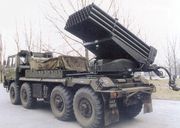
- RM-70 (raketomet vzor 1970): In 1972 the Czechoslovakian army introduced its own version of the BM-21, designated the RM-70. It consists of a bank of 40 launch tubes arranged in 4 rows of 10 mounted on an eight-by-eight 10 ton modified Tatra T813 truck. Unlike the BM-21, the RM-70 has an armoured cab and enough room behind it to allow for the storage of further 40 rockets.
- RM-70/85: Modification of RM-70 on unarmored Tatra T815 truck.
Poland
- WR-40 "Langusta" (eng. European spiny lobster) (wyrzutnia rakietowa means rocket launcher): This is a modern Polish version with a new fire control system (with ballistic computer BFC201 and navigation system Sigma 30) and a modified launcher based on the Jelcz P662D.35G-27 6x6 truck (produced by Jelcz-Komponenty). The first vehicle entered service in March 20, 2007. Probably about half of all 227 Polish BM-21 launchers will be converted into WR-40 launchers. New, modern types of munition were also developed for the launcher: the range is approximately 42 km (26 mi) for fragmentation-HE rockets "Fenix" and 32 km (20 mi) for cargo rockets. The Jelcz P662.D.35 truck with lightly armoured cab is also believed to be the base of a Polish MLRS complex, which will possibly be developed in the future.
Egypt
The Egyptians domestically manufacture the rockets "Sakr-36" and "Sakr-18" with a respective range of 36 and 18 km (11 mi), and the latest "Sakr-45" with a superior range of 45 km (28 mi). Rather than a standard HE-Frag round, the Egyptian military prefers a 23-kilogram (51 lb) cluster munition, which can be extremely effective against lightly armored equipment and troop concentrations. Both rockets, as well as the original Soviet models of course, are fired by locally manufactured rocket launchers like the RL-21 (copy of BM-11) and RC-21 (copy of BM-21, similar to the Hadid HM20). The Helwan Machine Tools Company also produces portable systems with one, three, four and eight launch tubes.
Gaza Strip
Hamas and other armed organisations in the Gaza Strip do not operate BM-21 truck-based launchers.[1]
They have used small man-portable launchers for rocket attacks against Israel, using improvised Qassam rockets, and individual 122 mm rockets which have been smuggled into Gaza, including the type used as ammunition for the BM-21 Grad and other Katyusha rocket launchers. The 122 mm rockets used by these groups in Gaza have a range of about 40 km (25 mi), and can reach the Israeli towns of Ashdod, Beer-Sheva, Ofakim, Gedera and Gan Yavne.
Ethiopia
The Homicho Ammunition Engineering Complex produces the rockets while the Bishoftu Motorization Engineering Complex produces the launching tubes and has converted existing trucks to diesel engine. Bishoftu motorization has also produced a six tube launcher to be mounted on light trucks.
North Korea (DPRK)
- BM-11: North Korean 30-tube version. The tubes are arranged in 2 banks of 15; all rockets can be fired in as little as 15 seconds. The basis for the BM-11 system is a Japanese manufactured Isuzu chassis.
- MRL 122 mm M1977: US DIA code for a system that appears to be a direct copy of the BM-21 "Grad".
- MRL 122 mm M1985: This is a more modern version, based on a Isuzu 6x6 truck and probably with a 40-round reload-pack mounted between the cab and the launcher
Iran
D.I.O. from Iran produces copies of the BM-11 and BM-21 systems that can fire the original Soviet rockets as well as the locally developed "Arash" with a range of 20.5 km (12.7 mi). There is also a rocket with a range of 75 km (47 mi).
- HM20 - This is the Iranian version of the BM-21, mounted on a Mercedes-Benz 2624 6x6 truck. The launch pack however consists of 2 packs of 20 tubes. Reportedly there is also a version with an automatic reload-system.
- HM23 - Lighter 16-round version with two packs of 8 launch tubes.
- HMxx - Iranian version of the 30-round BM-11, based on a Mercedes-Benz LA 911B 4x4 truck. Some vehicles are equipped with a light hydraulic crane.
Pakistan
- KRL 122 - Kahuta Research Laboratories from Pakistan have developed a rocket launcher that is very similar to the North-Korean BM-11. The KRL 122 was originally based on an Isuzu truck but later models use the Reo M35 truck. Some sources mention the designator Gadab or Azar. Except for the original Soviet rockets, the "Yarmuk" developed by Pakistan Ordnance Factories can be launched.
Romania
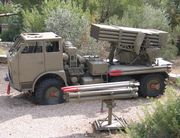
- APR-21 (aruncator de proiectile reactive - rocket launcher): Romanian 21-round launcher (3 rows of 7) mounted on a Bucegi SR-114 four-by-four chassis. No longer used by the Romanian Army but some vehicles have been exported to Nigeria and Croatia. Morocco has the launch pack mounted on a Kaiser M35 truck.
- APR-40: Initially this designator was used for the original BM-21 "Grad" in Romanian service, but Aerostar SA has developed an improved model, based on a DAC-665T six-by-six truck. A slightly improved model, called APRA-40 or 40 APRA 122 FMC is based on the DAC 15.215 DFAEG truck. Each launcher is normally accompanied by a re-supply truck MITC with a 6t crane and a trailer RM13. The system is also used by Botswana, Bosnia, Cameroon, Croatia, Iran, Iraq, Liberia and Nigeria.
- LAROM or LAROM 160: This is an upgraded version that was developed in cooperation with Israel. The launch vehicle is based on the truck chassis DAC 25.360 DFAEG, fitted with two launch packs with each 20 122 mm tubes or 13 160 mm tubes.[2] The LAROM 160 can fire rockets like the LAR Mk.IV with a range of 45 km (28 mi). The system entered service with the Romanian Land Forces in 2002.[3]
South Africa
- Valkiri: This is an improved South African design by Denel using 127 mm rockets.
- Bateleur: A newer, more accurate version of the Valkiri. Based on the Samil 100 military truck chassis. Also produced by Denel.
Projectiles
| Origin | Ammunition type | Minimum range | Maximum range | Length | Weight | Warhead weight | ||||||
|---|---|---|---|---|---|---|---|---|---|---|---|---|
| metres | miles | metres | miles | metres | ft in | kg | lb | kg | lb | |||
| 9M22U (M-21OF) | USSR/Russia | Fragmentation-HE | 5,000 | 3.1 | 20,380 | 12.66 | 2.87 | 9 ft 5 in | 66.6 | 147 | 18.4 | 41 |
| 9M28F | USSR/Russia | Fragmentation-HE | 1,500 | 0.93 | 15,000 | 9.3 | 2.27 | 7 ft 5 in | 56.5 | 125 | 21.0 | 46 |
| 9M28K | USSR/Russia | Anti-tank mines | 13,400 | 8.3 | 3.04 | 10 ft 0 in | 57.7 | 127 | 22.8 | 50 | ||
| 9M43 | USSR/Russia | Smoke | 20,000 | 12 | 2.95 | 9 ft 8 in | 66 | 150 | 20.2 | 45 | ||
| 9M217 | USSR/Russia | Anti-tank submunitions | 30,000 | 19 | 3.04 | 10 ft 0 in | 70 | 150 | 25 | 55 | ||
| 9M218 | USSR/Russia | HEAT submunitions | 30,000 | 19 | 3.04 | 10 ft 0 in | 70 | 150 | 25 | 55 | ||
| 9M519 | USSR/Russia | RF jammer | 18,500 | 11.5 | 3.04 | 10 ft 0 in | 66 | 150 | 18.4 | 41 | ||
| 9M521 | USSR/Russia | Fragmentation-HE | 40,000 | 25 | 2.87 | 9 ft 5 in | 66 | 150 | 21 | 46 | ||
| 9M522 | USSR/Russia | Fragmentation-HE | 37,500 | 23.3 | 3.04 | 10 ft 0 in | 70 | 150 | 25 | 55 | ||
| PRC-60 | USSR/Russia | Underwater charge (for BM-21PD) | 300 | 0.19 | 5,000 | 3.1 | 2.75 | 9 ft 0 in | 75.3 | 166 | 20 | 44 |
| Type 90A | China | Fragmentation-HE | 12,700 | 7.9 | 32,700 | 20.3 | 2.75 | 9 ft 0 in | 18.3 | 40 | ||
| M21-OF-FP | Romania | Fragmentation-HE | 5,000–6,000 | 3.1–3.7 | 20,400 | 12.7 | 2.87 | 9 ft 5 in | 65.4 | 144 | 6.35 | 14.0 |
| M21-OF-S | Romania | Fragmentation-HE | 1,000 | 0.62 | 12,700 | 7.9 | 1.927 | 6 ft 3.9 in | 46.6 | 103 | 6.35 | 14.0 |
| Oghab | Iran | HE fragmantation | 45,000 | 28 | 4.82 | 15 ft 10 in | 360 | 790 | 70 | 150 | ||
| Fajr-3 | Iran | HE fragmantation | 43,000 | 27 | 5.2 | 17 ft 1 in | 407 | 900 | 45 | 99 | ||
| Fajr-5 | Iran | HE fragmantation | 75,000 | 47 | 6.485 | 21 ft 3.3 in | 915 | 2,020 | 90 | 200 | ||
| Sakr-45A | Egypt | AT / AP submunitions | 42,000 | 26 | 3.310 | 10 ft 10.3 in | 67.5 | 149 | 24.5 | 54 | ||
| Sakr-45B | Egypt | Fragmentation-HE | 45,000 | 28 | 2.900 | 9 ft 6.2 in | 63.5 | 140 | 20.5 | 45 | ||
Also Incendiary, Chemical, Illumination, Antipersonnel mines.
Operators
 Afghanistan – Afghan National Army
Afghanistan – Afghan National Army Algeria – 250
Algeria – 250 Angola – 75
Angola – 75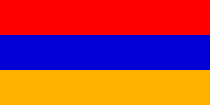 Armenia – 50
Armenia – 50 Azerbaijan – 63
Azerbaijan – 63 Bangladesh – KRL 122, Type 90B
Bangladesh – KRL 122, Type 90B Belarus - BM-21 and BM-21A "BelGrad"
Belarus - BM-21 and BM-21A "BelGrad" Bosnia and Herzegovina – 6
Bosnia and Herzegovina – 6 Bulgaria – about 100 active, some 200 in storage
Bulgaria – about 100 active, some 200 in storage Burkina Faso – 10
Burkina Faso – 10 Burma – 230
Burma – 230 Central African Republic – 5
Central African Republic – 5 Cambodia – 100
Cambodia – 100 Cameroon – 20
Cameroon – 20 Chad – 4
Chad – 4 Croatia – 64
Croatia – 64 Cuba – 250
Cuba – 250 Cyprus – 4
Cyprus – 4 Republic of the Congo – 6
Republic of the Congo – 6 Democratic Republic of the Congo – 6
Democratic Republic of the Congo – 6 Djibouti
Djibouti Ecuador – 10
Ecuador – 10 Egypt – 60
Egypt – 60 Eritrea – 25
Eritrea – 25 Ethiopia – 10
Ethiopia – 10 Finland – 24 units. Known as 122 RAKH 76. Now withdrawn from service.
Finland – 24 units. Known as 122 RAKH 76. Now withdrawn from service. Gaza – Hamas and other militants have no BM-21 Grad launchers, but use 122 mm ammunition in small launchers.
Gaza – Hamas and other militants have no BM-21 Grad launchers, but use 122 mm ammunition in small launchers. Georgia
Georgia Greece – 116 RM-70
Greece – 116 RM-70 Hungary – 46
Hungary – 46 Indonesia – N/A RM-70 (operated by marines)
Indonesia – N/A RM-70 (operated by marines) India – 150+
India – 150+ Iran – 100+
Iran – 100+ Iraq – 55
Iraq – 55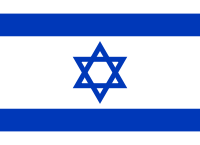 Israel – 50 captured,not in active service
Israel – 50 captured,not in active service Kazakhstan – 100[4]
Kazakhstan – 100[4] Kyrgyzstan – 21[5]
Kyrgyzstan – 21[5] Lebanon – 30-including some BM-11
Lebanon – 30-including some BM-11 Liberia – ?
Liberia – ? Morocco – 36
Morocco – 36 Mongolia – ?
Mongolia – ? Macedonia – 12
Macedonia – 12 Mali – 2
Mali – 2 Mozambique – 5
Mozambique – 5 Namibia – 4
Namibia – 4 Nicaragua – 30
Nicaragua – 30 Niger – 11 APR-21 and APR-40
Niger – 11 APR-21 and APR-40 North Korea
North Korea Pakistan – 40
Pakistan – 40 Peru – 14 [6]
Peru – 14 [6] Poland – 219[7]
Poland – 219[7] Romania – 352 APR-40 (124 being upgraded to LAROM)
Romania – 352 APR-40 (124 being upgraded to LAROM) Russia – 1,750 [8]
Russia – 1,750 [8] Sahrawi Arab Democratic Republic - 10[9]
Sahrawi Arab Democratic Republic - 10[9] Somaliland – 75
Somaliland – 75 South Ossetia – 5
South Ossetia – 5 Syria – 250
Syria – 250 Tajikistan – 10[10]
Tajikistan – 10[10] Tanzania – 48
Tanzania – 48 Turkmenistan – 56[11]
Turkmenistan – 56[11] Uzbekistan – 36[12]
Uzbekistan – 36[12] Ukraine – 600
Ukraine – 600 Vietnam – 800
Vietnam – 800 Yemen – 280
Yemen – 280 Zambia – 50
Zambia – 50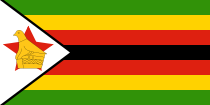 Zimbabwe – 25
Zimbabwe – 25
See also
- Katyusha, BM-13, BM-8, and BM-31 multiple rocket launchers of World War II
- BM-14 140 mm multiple rocket launcher
- BM-27 Uragan 220 mm multiple rocket launcher
- BM-30 Smerch 300 mm multiple rocket launcher
- ASTROS II (Brazil)
References
- Multiple Rocket Launchers, Romania - Jane's Armour and Artillery, 2003.
- Russia's Arms Catalog 2004
- EDISI KOLEKSI ANGKASA PERANG HIZBULLAH ISRAEL, Edition of September 2006
- ↑ Israeli Ministry of Foreign Affairs, “Terror in Gaza: Twelve months since the Hamas takeover”, 16 June 2008.
- ↑ Galerie Foto
- ↑ LAROM – reactive missile launcher
- ↑ Kazak Army Equipment
- ↑ Kyrgyz Army Equipment
- ↑ Index of Peruvian Military Equipment
- ↑ "MILITARIUM - Uzbrojenie Wojska Polskiego w 2008 r"
- ↑ Russian Army Equipment
- ↑ Frente Polisario
- ↑ Tajik Army Equipment
- ↑ Turkmen Army Equipment
- ↑ Uzbek Army Equipment
External links
- 122 mm Multiple Rocket Launcher (MRL) "GRAD" on the Ural-375 6x6 truck chassis – Walk around photos
- Globalsecurity.org
- Enemyforces.com
- Splav State Research and Production Enterprise
- BM-11 at FAS.org
- RM-70 at Army.cz
- WR-40 Langusta at krucjata.org.pl (Polish)
- Iraq BM-21 Picters
- Iraq BM-21 Ger.
|
||||||||||||||||||||||||||||||||||||||||||||||||||||||||||||